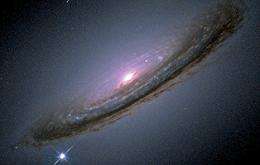Super Supernova: White Dwarf Star System Exceeds Mass Limit

(PhysOrg.com) -- An international team led by Yale University has, for the first time, measured the mass of a type of supernova thought to belong to a unique subclass and confirmed that it surpasses what was believed to be an upper mass limit. Their findings, which appear online and will be published in an upcoming issue of the Astrophysical Journal, could affect the way cosmologists measure the expansion of the universe.
Cosmologists use Type Ia supernovae—the violent explosions of dead cores of stars called white dwarfs—as a kind of cosmic ruler to measure distances to the supernovae's host galaxies and, as such, to understand the past and future expansion of the universe and explore the nature of dark energy. Until recently, it was thought that white dwarfs could not exceed what is known as the Chandrasekhar limit, a critical mass equaling about 1.4 times that of the Sun, before exploding in a supernova. This uniform limit is a key tool in measuring distances to supernovae.
Since 2003, four supernovae have been discovered that were so bright, cosmologists wondered whether their white dwarfs had surpassed the Chandrasekhar limit. These supernovae have been dubbed the "super-Chandrasekhar" supernovae.
Now Richard Scalzo of Yale, as part of a collaboration of American and French physicists called the Nearby Supernova Factory, has measured the mass of the white dwarf star that resulted in one of these rare supernovae, called SN 2007if, and confirmed that it exceeded the Chandrasekhar limit. They also discovered that the unusually bright supernova had not only a central mass, but a shell of material that was ejected during the explosion as well as a surrounding envelope of pre-existing material. The team hopes this discovery will provide a structural model with which to understand the other supermassive supernovae.
Using observations from telescopes in Chile, Hawaii and California, the team was able to measure the mass of the central star, the shell and the envelope individually, providing the first conclusive evidence that the star system itself did indeed surpass the Chandrasekhar limit. They found that the star itself appears to have had a mass of 2.1 times the mass of the Sun (plus or minus 10 percent), putting it well above the limit.
Being able to measure masses for all parts of the star system tells the physicists about how the system may have evolved—a process that is currently poorly understood. "We don't really know much about the stars that lead to these supernovae," Scalzo said. "We want to know more about what kind of stars they were, and how they formed and evolved over time."
Scalzo believes there's a good chance that SN 2007if resulted from the merging of two white dwarfs, rather than the explosion of a single white dwarf and hopes to study the other super-Chandrasekhar supernovae to determine whether they, too, could have involved a merger of two white dwarfs.
Theorists continue to explore how stars with masses above the Chandrasekhar limit, which is based on a simplified star model, could exist without collapsing under their own weight. Either way, a subclass of supernovae governed by different physics could have a dramatic effect on the way cosmologists use them to measure the expansion of the universe.
"Supernovae are being used to make statements about the fate of the universe and our theory of gravity," Scalzo said. "If our understanding of supernovae changes, it could significantly impact of our theories and predictions."
More information: Paper: arxiv.org/abs/1003.2217
Provided by Yale University



















